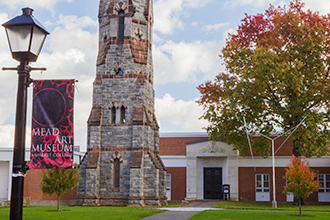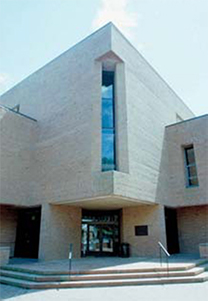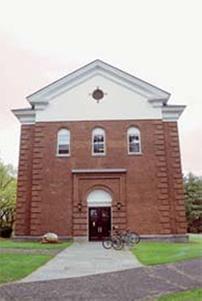Building Booms
70 Years Ago
A Home for Art
In 1949 Amherst magazine marked the opening of a new building for its art collection, financed from the bequest of architect William R. Mead, class of 1867, and his wife, Olga.

The Spring 1949 issue made special note of the Rotherwas Room, whose walnut paneling and oak mantelpiece date to 1611. Removed in 1731 from an estate in Herefordshire, England, it was eventually donated to Amherst by Herbert Lee Pratt, class of 1895. At the Mead, it would “serve as an adjunct to both main exhibition space and library,” the magazine noted. “Here one may counter ‘museum fatigue’ in an easy chair and enjoy the views of the Pelham Hills and the Holyoke Range through its ample Gothic windows.”
Between 1949 and 1962, Robert Frost offered public readings in the Rotherwas Room. Today it’s a showcase for contemporary art.
50 Years Ago
A Home for Science

The grounds of the College visibly changed with construction of the (then unnamed) Merrill Science Center in 1969, but speakers at the building’s dedication had their eyes set well above the ground.
“The Search for Life Beyond the Earth” was the topic of a morning symposium at the dedication festivities. Astronomers Carl Sagan and Frank Donald Drake presented papers, with Sagan, according to the Winter 1969 magazine, describing new, high-resolution techniques for viewing and photographing the surface of the moon, as well as the use of spectroanalysis for discerning such things as the amount of water vapor in the Mars atmosphere.
A panel discussion followed “in which there was a high degree of agreement on the point that, within the not too distant future, man would be making contact, if not physically then by electronic means, with other forms of intelligent life in the universe.”
As of this writing, the stars haven’t—as far as we know—responded.
20 Years Ago
A Home for Students

Over the College’s lifetime, some buildings have come and gone, while others have adapted to changing needs.
Appleton Hall, which was built in 1855 as a “cabinet” to display Edward Hitchcock’s collection of dinosaur tracks and other curiosities, reopened in 1999 as a dorm, following a $2.1 million remodel.
Appleton became an academic building in the 1930s. Its original collections traveled elsewhere on the campus, notably to Pratt (itself a former gymnasium and today a dorm) and the Beneski, which opened in 2006. Of Appelton’s third act as a dorm, the magazine said that while contractors gut- ted the interior, “they preserved the dignified exterior of the old landmark build- ing with its arched third-story windows, quoins and stately end gables. Some of the third-floor rooms should be especially popular, with deep windowsills and distant views of the Holyoke Range.” Today it’s home to a collection of first-year students.